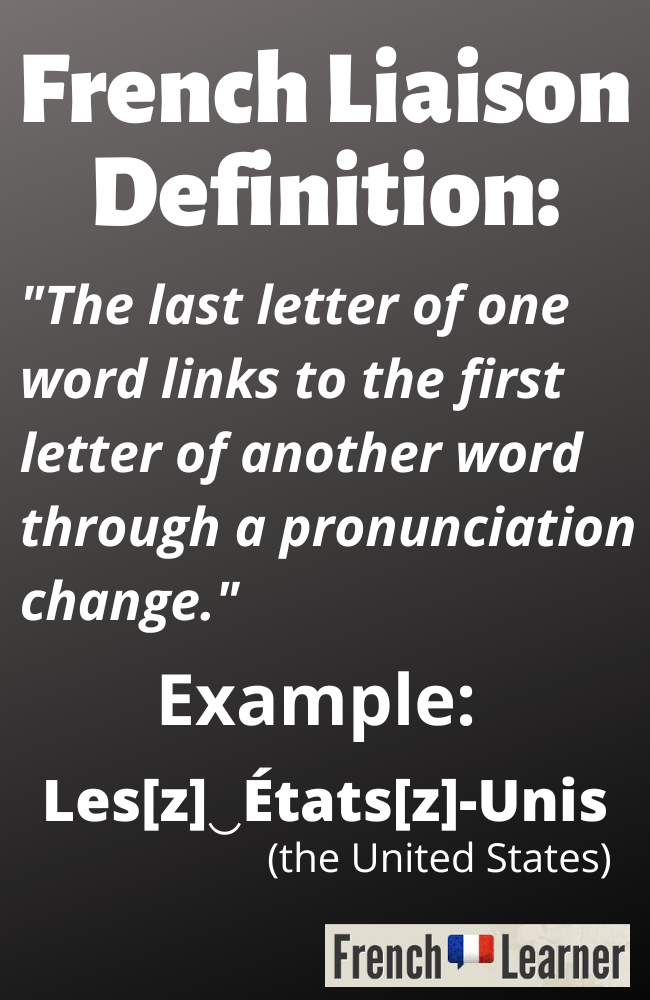In French, a liaison is when the final consonant of certain words is pronounced and linked with the following word, which begins with a vowel. It’s not always easy to know when to a liaison occurs between two French words, but this grammar trick will help clear things up.

What is the French liaison?
Liaison might be one of the more complicated French rules out there. But luckily, there is a pretty easy trick to remember when to use a liaison. Before we get into how to use it, let’s start with a quick definition of what it is and why liaisons are used in French.
A liaison is when the last letter of one word links to the first letter of another word through a pronunciation change.

Why do liaisons exist in French?
Over time, languages have evolved to be as easy to speak as possible. We’ve gotten rid of sounds that don’t flow and added in sounds that do. One example of these sounds is the glottal stop.
A glottal stop is when your vocal cords close after a sound. In English, we keep this awkward sound from happening when we use “an” instead of “a” in front of a word that starts with a vowel.
Similar to the English rule on when to use “an,” liaisons occur with words that begin with vowels. They happen when a word that normally ends with a silent constant (think: les, mes, ont, and est) occurs before certain words that begins with a vowel or a silent “h” sound.
Liaison Pronunciations
1. S and X to Z
In situations where liaisons occur, the “s” or “x” at the end of the first word will turn into a “z” sound. Two examples are les‿ananas and deux‿amis.
*The tie symbol (‿) represents two words being connected by liaison with a new sound. The two words are still written separately and the ‿ is just there for educational purposes.
2. D to T
In other liaisons, the “d” sound changes to “t.” This happens in the sentence “Quand‿est-ce que tu vas au supermarché ?” This also happens with the word grand.
3. Silent T to pronounced T
With liaison, the “t” at the end of certain words will be pronounced. This occurs in the sentence il est‿allé. This also happens with the word petit, comment, and tout.
4. Nasal N and M to pronounced N and M
Nasal “n” and “m” sounds will also change to their “nnn” and “mmm” pronunciations (which are how they’re pronounced in the French alphabet) with liaison. For example, instead of saying “on” like you usually would, in the sentence “on‿a mangé” you’ll pronounce the “n” at the end of “on.”

Liaison Rules and The Three Types
When it comes to liasons there are required liaisons, optional liaisons, and forbidden liaisons. The trick to remembering when to do liason is to never do it if the two words aren’t grammatically linked. If they are, make sure they fall under one of the required liaison categories.
Required Liaison Examples
1. Determiners
Determiners are words used to modify nouns. A liaison always occurs between the determiner and the noun it’s modifying.
Two examples are ces‿élèves and nos‿hommes.
2. Subject Pronoun-Verb Pairings
You’ll also use liaison between subject pronoun-verb pairings. Elles, ils, nous, vous, and on all end in silent constants, which means when they come before a verb that begins with a vowel, a liaison is required.
A few examples are ils‿ont, nous‿avons, and vous‿êtes.
You can also have indirect subject pronoun-verb pairings that use liaison. For example, je vous aime.
3. After Est and Sommes
The third person singular (est) and first person plural (sommes) forms of être always have liaison when they come before words that begin with vowels.
Liaison occurs in instances like nous sommes‿allé and quelle heure est-il ?
Forbidden Liaison Examples
Usually, liaison occurs between words that are grammatically linked. But there are a few instances where two words are grammatically linked but liaison doesn’t occur.
Adverbs and Adjectives
In most cases, you will not connect adverbs and adjectives with liaison. But there are a few exceptions to this rule.
Pre-posed adjectives, which are adjectives that come before the noun, will use liaison. A few of these common adjectives are bon, mauvais, vilain, grand, and faux.
Adverbs like très, bien, comment, and tout are also exceptions to this rule.
You’ll also never have liaison:
- After inversion
- After et
- With numbers
- After names
- Before h aspiré
Optional Liaison Examples
This type of liaison will never get you into trouble. But it can make you sound a little uppity because most French speakers do not choose to use liaison when it’s optional. Here are a few times you can optionally use liaison:
- After short adverbs and conjunctions (mais, trop, etc.)
- After pas
- Before a name
- After the other forms of être and avoir
